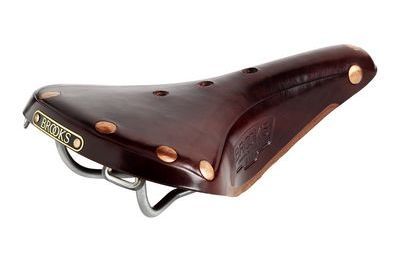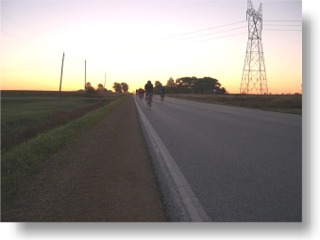 My
main avocation the past fifteen years has been road biking, especially
longer distances ('ultra cycling'). I try to ride about 6,000
miles per year, not too much by ultra standards, but about all I can
manage with a family and a career as an astronomer. I commute to work
(20 miles round trip on shortest route) on warm months of the
year (April-October) if the road conditions aren't too
terrible. My
main avocation the past fifteen years has been road biking, especially
longer distances ('ultra cycling'). I try to ride about 6,000
miles per year, not too much by ultra standards, but about all I can
manage with a family and a career as an astronomer. I commute to work
(20 miles round trip on shortest route) on warm months of the
year (April-October) if the road conditions aren't too
terrible.Ultracycling Web ResourcesLocally, there are a several local bike clubs in Iowa City, including Bicyclists of Iowa City, the 2-Bee Racing club, and a mountain bike club, the Iowa City Coalition of Off-Road Riders.Statewide, the Bike Iowa web page is a great resource for finding cycling events of all types throughout Iowa. There's an active local group of long-distance cyclists in eastern Iowa, including the Cedar Valley Cyclists, who run an annual set of 200K - 600K brevets and the Big Dogs Endurance Cycling club. Two organizations which organize ultra cycling events on a national level are the Ultra Marathon Cycling Association , sponsors of the Race Across America, ultracycling's premier racing event, and Randonneurs USA, which coordinates US riders who wish to qualify for the granddaddy of all ultracycling events, Paris-Brest-Paris. PBP, as it is universally known among ultracyclists, is a mythical 1200 km (760 mile) ride from the western Parisian suburb of Saint-Quentin-en-Yvelines to the coast at Brest and back again. In order to qualify to enter PBP, riders must complete a series of officially sanctioned brevets (200 km, 300 km, 400 km, 600 km) in under specified time limits and send their brevet cards to Paris. PBP is only offered once every four years (including 2007) and the brevets must be completed in the same year. Over 4,000 riders from around the world participate in PBP, all striving to complete the ride in less than 90 hours, thereby becoming an 'ancien' and earning the coveted finisher's medal. I did this ride in 1995 (in 72:10) - it was one of the most enjoyable rides of my life. Finally, there's the annual bike ride across Iowa, RAGBRAI, which my family and I have done many years since 1990, except when the sunny prospect of another hot and humid trip through the bucolic Iowa countryside is somehow supplanted by a week riding out West, for example in the Rockies with the Pedal the Peaks tour. These tours are much more challenging than RAGBRAI, both in terms of distance and elevation gain, but it was beautiful and amazingly well organized - highly recommended. Ultracycling log2001. The year 2001 was not been a great year for big miles, but the rides have been enjoyable. In June I rode the TOMRV ride in 'express' mode (single day), about 180 miles, and the National 24 Hour Challenge near Grand Rapids Michigan. I also showed up for John Thier's Dubuque double century ( a Big Dog club ride), which includes one of the steepest hills in the Midwest! I had grand plans to finally break 400 miles at the UMCA 24 Hour Championships, but after a MCL knee sprain trekking in Kyrgyzstan in July, I settled for a very enjoyable 210 mile ride and a good night's sleep. The Cochise County Cycling Classic in Arizona on October 6 was great fun. My friend Terry Brown (from Sierra Vista) and I did the 156 mile event as a team,and finished in just over 10 hours. We were on track for a 9 hour finish at the 100 mile mark (top of Texas Canyon), but the headwinds in Sulphur Springs Valley really took its toll. 2002. Another modest year in 2002. The only significant event was the UMCA 24 Hour Championships in mid-September, with a 345 mile finish. This included 2.5 hours off the bike, caused by not having any support crew (and tiredness!) 2003. Another so-so biking year. Connie and I had a great week on our tandem bike at Pedal the Peaksith daily rides up to 128 miles and 6,000 climbing feet in northern Colorado and southern Wyoming. Add a few doubles and a 306 mile ride at the UMCA championships in September. 2005. Several week-long organized rides including Hell Week Las Vegas (800 hot miles in 8 days, May) and Pedal the Peaks (June, Northern New Mexico) again. In early September, sons Chris (28) and Matt (23) joined me at the UMCA Midwest 12/24 hour championships for a leisurely double century ride. In October I did the Cochise County Classic 157 again, but once again could not break 10 hours (10:15). 2006. Late May featured a solo tour from Fraser to Grand Junction Colorado over several less-traveled mountain passes (e.g. Gore, McClure) . In June I did another solo tour in Southern Utah, visiting Zion, Bryce, and Cedar Breaks parks. In July, I had a pretty good 20K time trial at the Iowa Games, managing 32:10 (23.3 mph average). In early September I did the 12-hour race at the UMCA Midwest 12/24 hour championships and managed to ride 207 miles, a personal best for 12 hours. It was also good enough for first place in the 60-69 age category (don't laugh). 2007. A few nice trips, including rides in Switzerland with my son Chris (Klaussenpass ride photos), several days on the Blue Ridge Parkway near Asheville NC with Chris and Matt, and another 12-hour race at the UMCA Midwest 12/24 hour championships. I managed to ride 207 miles again, but was off-course for 4 miles, so my official total was 203. This was (just) good enough for another first place in the 60-69 age category (don't laugh again). 2008. In mid-May I rode a lovely 540 mile route from Las Vegas to Green River (UT), with stopovers in Overton [NV], St. George, Orderville, Tropic, Boulder, and Hanksville. The first two days were unexpectantly tough, with fierce [30-50 mph] headwinds almost the entire day. I ran out of water halfway up 'Utah Hill' (old US 91) , now a lonely two-lane backroad between Mesquite and St. George. It features a steady 3,000 ft climb, with the steepest part near the top, and no services. The combination of headwinds, relentless climbing, and afternoon desert heat made this 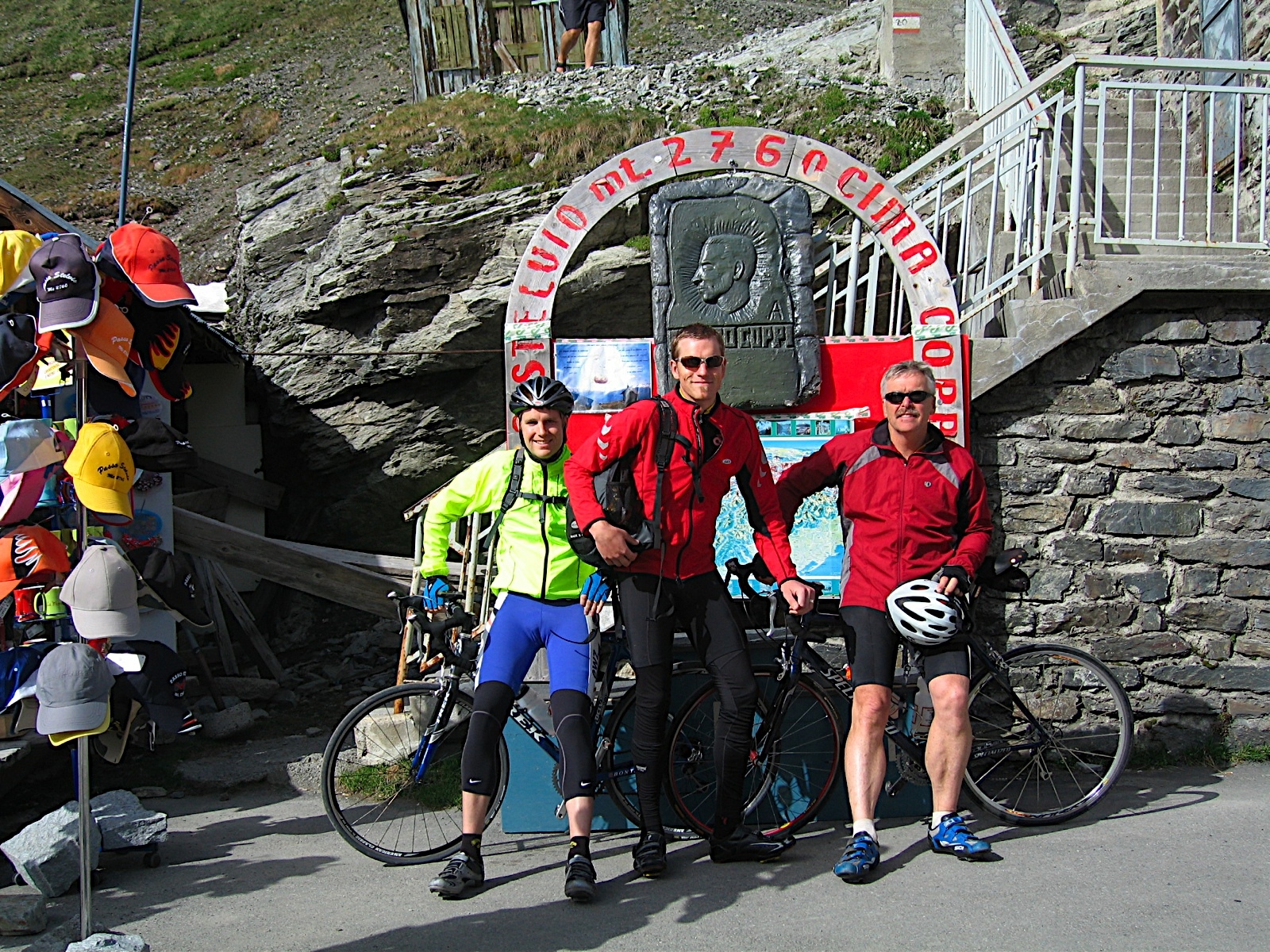 a
tough climb. The highlight of the trip had to be the 'Hogback' between
Escalante and Boulder along Utah state higheway 12, a spectacular road
that every cyclist should do once in a lifetime. a
tough climb. The highlight of the trip had to be the 'Hogback' between
Escalante and Boulder along Utah state higheway 12, a spectacular road
that every cyclist should do once in a lifetime. I spent June in Switzerland where my oldest son Chris is a graduate student at ETH in Zurich. For my 62nd birthday we rode an epic route that included the famed Stelvio Pass in Northern Italy (2757m), a 6,000 ft climb in 24 km averaging 8%, with upper sections well above 10% grade. The picture at right is on top of the pass, with Chris on the left, our friend Forrest, and me at right. The arch behind commemorates the legendary Italian cyclist Fausto Coppi who won the Giro several times in the 1950's - the Stelvio has been a key stage in the Giro for many years. The day totalled nearly 11,000 ft of climbing in 85 miles. 2009. A good year, starting with a credit-card tour of the Blue Ridge Parkway in May. I flew to Charlottesville with my new Specialized Roubaix Pro hastily packed in a cardboard box. Naturally it got badly banged up in transit, so now I don't have to fret about small dings. The first day was pleasant 60 mile stroll to the Parkway on rural Virginia roads, including a delightful lunch at Batesville, a surprisingly steep climb to the BRP, and a fast descent to the Sugar Tree Inn. The next morning was a terrificly steep (18%?) but short [1km] climb back to the parkway, and a gorgeous ride to Peaks of Otter, It was only 60 miles away, but considerably more strenuous than it sounds, due to constant hills. In fact, that's pretty much the story riding the BRP, amazing scenery, but 80% on the time you are slowly climbing, with most grades in the 6-8% range, and some quite long, especially the 3000 ft climbs just after Peaks of Otter and Raleigh. After day three, my son Matt joined me and we rode two more days together, eventually leaving the BRP at Blowing Rock NC (great name), and rode over to Jonesborough TN meet Matt's girlfriend (now fiance)'s parents. June was Zurich again (quite a nice annual habit!) to visit Chris and family - he is finishing (I think) his PhD at ETH, so the Zurich thing might disappear at some point. Anyway, we did a number of nice rides, including a trip into the Schwarzwald in Germany. The rest of the summer seemed to evaporate fast, but I successfully defended my geezer-class (60-69) title for the fourth year in a row at the UMCA midwest 12- hour championships. I somehow broke my previous PR (207), with a 216 mile ride. The conditions were ideal (sunny, high-60's little wind), and my Roubaix was dialed in perfectly, so it was very likely a result of luck and equipment more than training. 2010. Another nice cycling season. In March I had an astronomical meeting in Kona, Hawaii, which conveniently has a bike rental shop with hundred's of high- 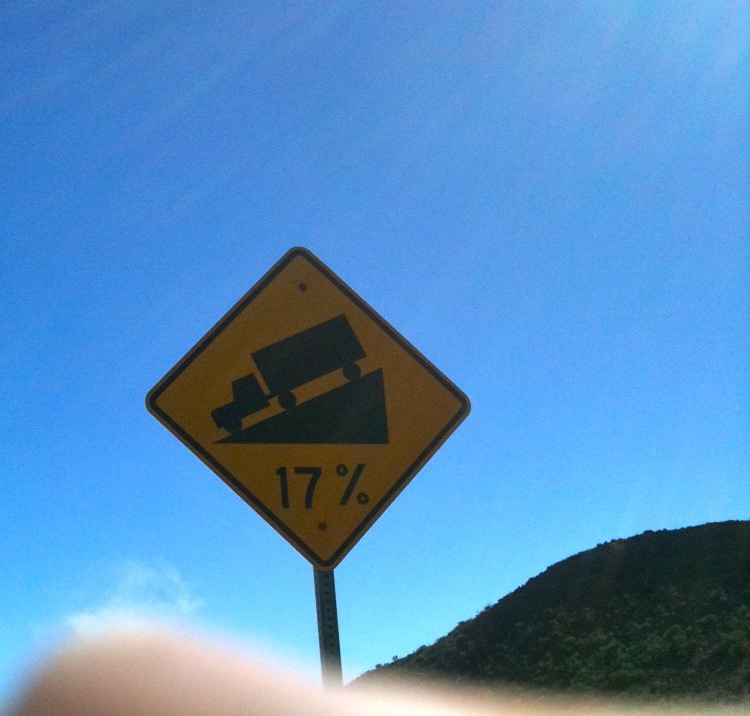 end
bikes (can you guess why?) I rented a sweet Specialized Roubaix and
rode the Queen-K highway every day after the meeting ended
[and some days even before!] One day I did the classic Ironman route to
Hawi - an interesting hippy-biker social mix - then over the hills
on the Hawi-Kohala mountain road to Waimea, and back to the coast.
Another day I climbed up to the Visitor Center on Mauna Kea
(9,400', including some 17% grades near the top). Most days were
unbelievably windy (30-50 mph), and the last few miles of the MK
climb were cold and wet, but it sure beat Iowa in early March. end
bikes (can you guess why?) I rented a sweet Specialized Roubaix and
rode the Queen-K highway every day after the meeting ended
[and some days even before!] One day I did the classic Ironman route to
Hawi - an interesting hippy-biker social mix - then over the hills
on the Hawi-Kohala mountain road to Waimea, and back to the coast.
Another day I climbed up to the Visitor Center on Mauna Kea
(9,400', including some 17% grades near the top). Most days were
unbelievably windy (30-50 mph), and the last few miles of the MK
climb were cold and wet, but it sure beat Iowa in early March.In June we visited my son Chris and his family in Zurich again, and did a second climb of the infamous Stelvio Pass (see 2008), This time we were joined by my youngest son Matt and his new bride Lara, who were touring Europe on a tandem for their honeymoon. We (my wife Connie and I) later joined Matt & Lara on a 10-day trip f 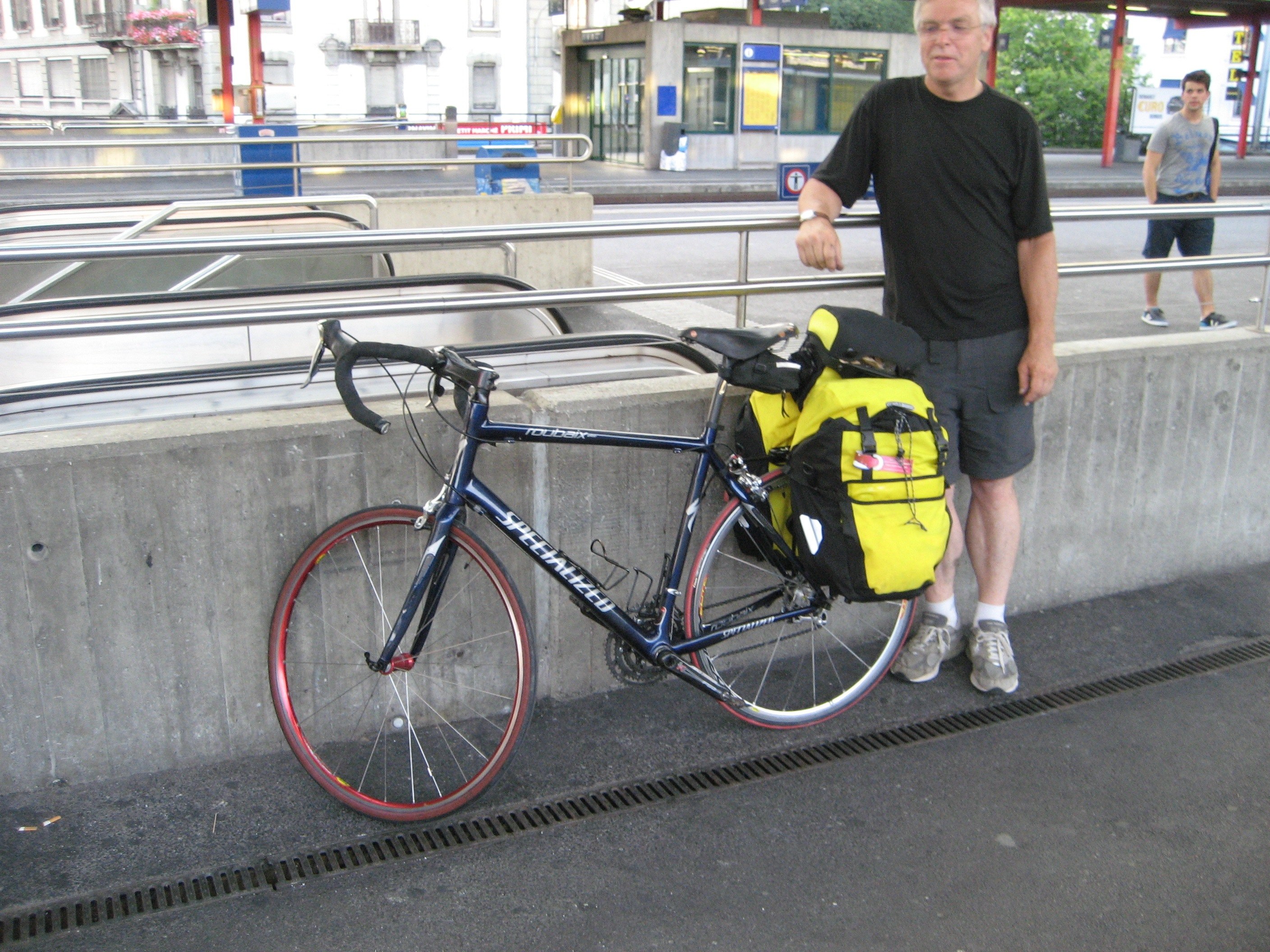 rom
Grenoble to Nice through the Haute Provence, including a traverse of
the equally infamous Mt. Ventoux (1900 m = 6000'). This is made more
challenging since the bike had about 30 lb of gear i.e. a 50 lb
loaded bike (not to mention my non-svelte carcass). I managed to
shred a tire but the Roubaix held up for 500 km - although after
returning to Zurich I popped a spoke on the Mavic helium front wheel. rom
Grenoble to Nice through the Haute Provence, including a traverse of
the equally infamous Mt. Ventoux (1900 m = 6000'). This is made more
challenging since the bike had about 30 lb of gear i.e. a 50 lb
loaded bike (not to mention my non-svelte carcass). I managed to
shred a tire but the Roubaix held up for 500 km - although after
returning to Zurich I popped a spoke on the Mavic helium front wheel.September was the usual UMCA 12-hr Midwest Championships in Western Illinois. It was fairly windy and cool, but not bad. However, I probably had not put enough training miles in and started developing knee pain and quad cramps at 180 miles with over an hour to go. I bagged it there, with only mild regrets. The right knee is still a bit sore (late November) after long rides, but not really painful. Bike Stable I currently own several road bikes and two mountain bike. This is clearly excessive, but I
find that it's a lot harder to get rid of bikes than acquire them! I currently own several road bikes and two mountain bike. This is clearly excessive, but I
find that it's a lot harder to get rid of bikes than acquire them!
Recommended equipment for ultras
Long Distance Biking Nutrition
|
